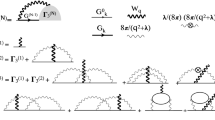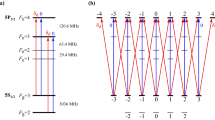Abstract
FOR some time now there has been some uncertainty in the literature of the correct value for the Einstein A coefficients for the ground state Λ doublet transitions of OH. Barrett1 calculated A = 2.66 × 10−11 sec−1 for the 1,667 Mc/s line using a matrix element |μij|2 taken from Dousmanis, Sanders and Townes2. This element is incorrect both because the form of its dependence on the rotational quantum number J was incorrectly given as [(J + 1)(2J + 1)]−1, and also because the element was incorrectly defined as (1). The appropriate definition is given below. The correct J-dependence, which is [J(J + 1)]−1, was given by Meyer3, in connexion with the Stark-effect determination of the OH dipole moment, μ because Meyer used an electric field directed so that only transitions of type ΔMJ = 0 occurred between the magnetic sub-levels characterized by quantum number MJ, the problem of combining these elements with those for which ΔMJ = ±1 to form an overall matrix element μij was not encountered. To derive the overall matrix element between the Λ doublet levels of the ground state of OH, Goss and Weaver4 combined the correct J-factor of Meyer with standard relative intensity formulae for hyperfine transitions as given by Townes and Schawlow5 to derive A = 0.9640 × 10−11 sec−1 for the 1,667 Mc/s line. They also used the most recent values for the OH dipole moment and the fine structure interaction constant, the calculation making use of the theory for intermediate coupling between Hunds's cases (a) and (b), as given by Dousmanis, Sanders and Townes2.
This is a preview of subscription content, access via your institution
Access options
Subscribe to this journal
Receive 51 print issues and online access
$199.00 per year
only $3.90 per issue
Buy this article
- Purchase on Springer Link
- Instant access to full article PDF
Prices may be subject to local taxes which are calculated during checkout
Similar content being viewed by others
References
Barrett, A., I.E.E.E. Trans. Military Electronics, MIL-8, 156 (1964).
Dousmanis, G., Sanders, T., and Townes, C., Phys. Rev., 100, 1735 (1955).
Meyer, R., thesis, Univ. Calif. (1961).
Goss, W. M., and Weaver, H., paper presented at Amer. Astro. Soc. Meet., Berkeley, 1965.
Townes, C., and Schawlow, A., Microwave Spectroscopy (McGraw-Hill, 1955).
Wang, S., Phys. Rev., 34, 243 (1929).
Condon, E., and Shortley, G., Theory of Atomic Spectra (Cambridge University Press, 1964).
Goss, W. M., and Spinrad, H., Astrophys. J., 143, 989 (1966).
Author information
Authors and Affiliations
Rights and permissions
About this article
Cite this article
TURNER, B. Einstein A Coefficient for the Λ Doublet Transitions of the Ground State of OH. Nature 212, 184–185 (1966). https://doi.org/10.1038/212184b0
Issue Date:
DOI: https://doi.org/10.1038/212184b0
This article is cited by
-
Natural masers:
Applied Physics (1976)
-
A Search for the ⋀Doublet Transition in the 2Π1/2, J=1/2 State of OH
Nature (1967)
-
Calculations of the Einstein A Coefficient for the 18 cm Transition of OH
Nature (1967)
-
Correction of Some Erroneous Calculations of the Einstein A Coefficient for the 18 cm Transition of OH
Nature (1967)
-
Einstein A Coefficients for the 18 cm Transitions of OH
Nature (1967)
Comments
By submitting a comment you agree to abide by our Terms and Community Guidelines. If you find something abusive or that does not comply with our terms or guidelines please flag it as inappropriate.



